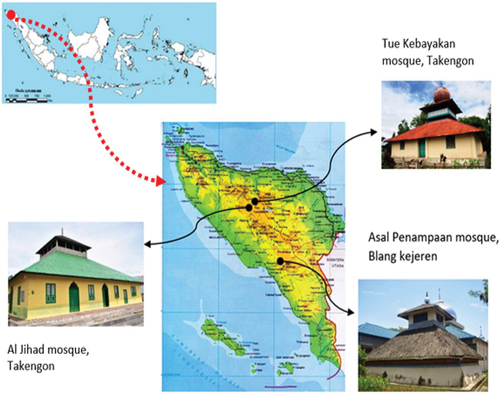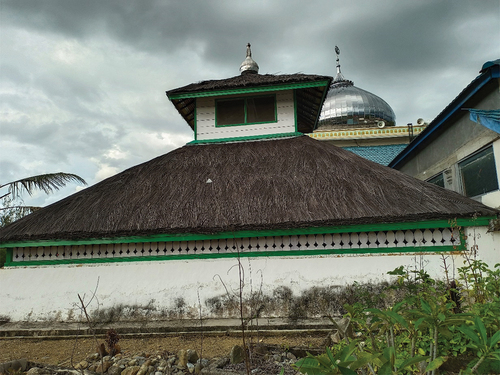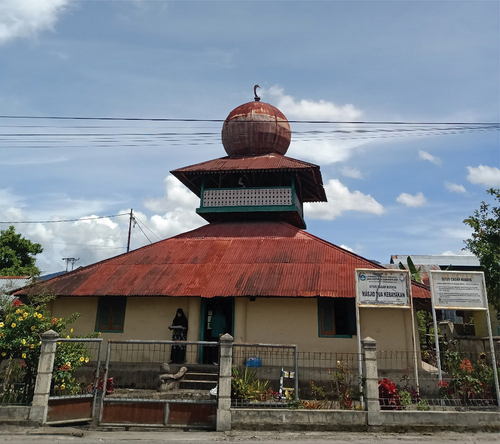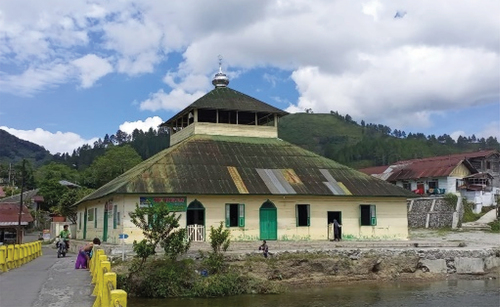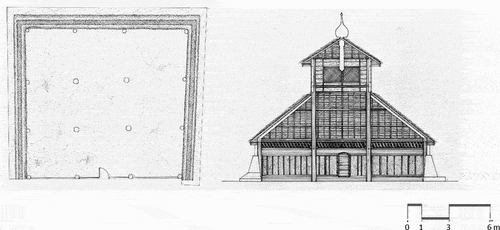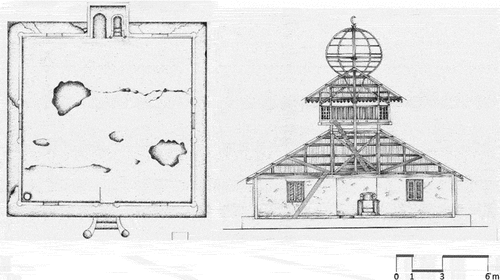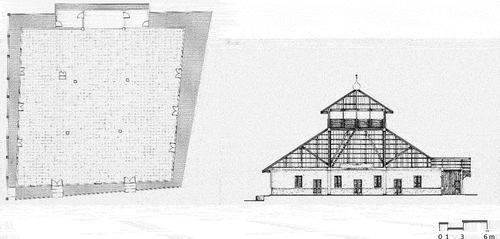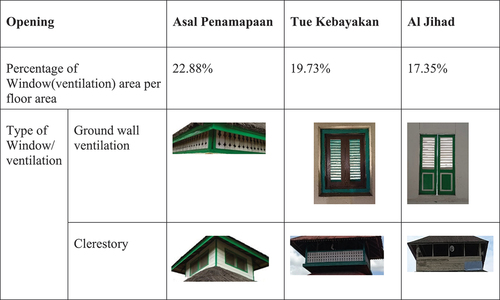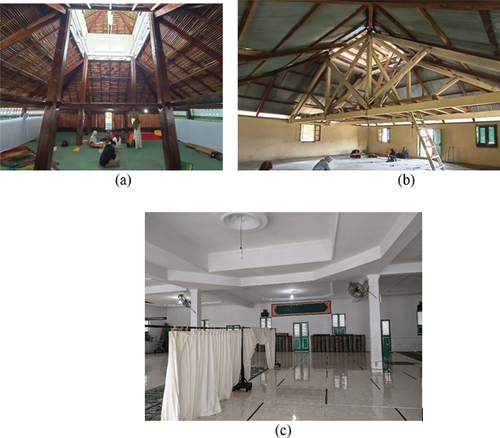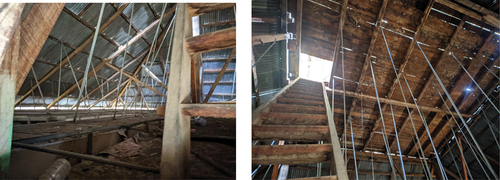ABSTRACT
The existing traditional architecture has a sustainable design that is adaptive to the environment. Old mosque is one of the traditional architectures that has withstood the test of time due to its adaptations to the environment. Mosques as religious buildings designed for Muslims to practice their religion lead to their design being convenient and sustainable. The purpose of this study is to evaluate the design elements of the old traditional mosques in Gayo highland of Indonesia, i.e. Asal Penampaan, Tue Kebayakan, and Al Jihad Mosques, so that a more sustainable approach to architecture may be developed. The methodology of this study is qualitative, carried out through observation and a literature review on the design and environmental elements of the mosque architecture. In this study, the design and environmental elements reviewed are limited to the building materials; the building floor plan and Structure; the openings; and the water bodies surrounding the mosques. The results showed that these traditional mosques have structures, materials, and designs that are adaptive to climate and the environment. The characteristics of this mosque include low embodied energy from the local materials and resilience to earthquakes through the Saka guru system, supported by mortise and tenon joint system.
1. Introduction
Old buildings such as mosques were primitively designed based on tradition and local knowledge. Some facts show that historical buildings built a hundred years ago successfully functioned with natural cooling or heating and used natural light (Fouseki et al. Citation2020; Rosana and Juan Citation2020). Traditional buildings, including old mosques can be a reference for today’s architecture with their unique, and worthy features, which can help to sustain modern buildings for a long time. These traditional architectural methods are ingenious solutions and may hold answers to solving today’s energy problems (Akyıldız and Olğun Citation2020). These solutions comply with sustainable traditional architecture including design principles, construction techniques, and material preferences which are compatible with the natural environment. Sustainable design principles also include the ability to optimize site potential; minimize non-renewable energy consumption; use environmentally preferable products/materials; protect and conserve water; enhance indoor environmental quality; and optimize operational and maintenance practices (Firląg and Piasecki Citation2018; Lami and Mecca Citation2021). Regarding this, several researchers have studied how mosques incorporate sustainable design principles. Akyıldız et al. studied the old mosque in Bahri, Turkey, and found the mosque employs sustainable architectural features through supportive planning, land settlement, local materials, and energy resource usage (Akyıldız and Olğun Citation2020). Sobri, et al. indicated that the Islamic manner of mosque design performs sustainable features (Sobri et al. Citation2021). Sustainability in the mosque also considers the easy accessibility for worshippers regardless of their physical abilities or disabilities (Sharif, Jalil, and Bekhet Citation2019).
Sustainable designs are the ways in which designers incorporate the surrounding environment into the building structure in order to create comfort, improve health, sustain strength and durability, and save energy (Šujanová et al. Citation2019). In a tropical region, buildings are commonly built using lightweight construction materials such as timber walls, leaf roofs, and stilt floors (Idham Citation2019; Nursaniah, Machdar, and Munir Citation2021). Traditional buildings are typically built with large openings for upper ventilation (Nwalusi et al. Citation2022). Large openings are commonly installed to provide a cool environment (Kariuki Citation2021; Sari and Rauzi Citation2021; Sobri et al. Citation2021). These characteristics can be seen in the traditional mosque and traditional house designs in Indonesia. These architectural characteristics are suitable for warm humid environments and are regarded as being a sustainable architectural design (Ghassan, Sari, and Munir Citation2021).
In this context, this study takes a closer look at the old traditional mosques. Since mosques are regularly visited by worshippers five times a day, they must be built with sustainability in mind. As previously mentioned, older mosques typically adopt indigenous architecture considering the local climate. The old traditional mosques studied in this article are located in Gayo Highland region of Indonesia. The region is climatically characterized by a mountainously warm humid environment. The Gayo highland is at an altitude of about 900–1350 m above sea level. It has two main districts, i.e. Takengon and Blangkejeren. The average air temperature is about 12°C to 23°C which is around 5°C lower than in lowland areas. The relative humidity is 70% and 80%, respectively, for Takengon and BlangKejeren (Gayo Citation2022; Sufi Citation2013). The mosques in Gayo Highland look similar to the lowland area; however, some elements are different to accommodate the local needs. With this reference, this study is aimed at identifying the sustainable approaches found in the old mosques in Gayo Highland and how they adapt to the local climate naturally, which is the most significant element to be considered when assessing sustainable architecture.
1.1. Sustainability and traditional mosque architecture
Local knowledge of architecture has a brilliant strategy to create an adaptive design with the environment (Looman Citation2017). From the architectural view, sustainability means maintaining the function of the building in to the future without sacrificing the natural resources for future generations (Ruggerio Citation2021). The sustainable building design includes the material selection and smart approach in employing the local climate and environment to attain energy efficiency (Najjar et al. Citation2019). The principle of climate suitability determines the building’s decision to look at the sunrise, taking into account the dominant wind. The principle of choosing the closest building materials revealed that the construction of buildings with local materials was the right planning decision (Akyıldız and Olğun Citation2020). Therefore, an architect needs to pay attention to environmental conditions in determining the right building envelope (Aslani, Bakhtiar, and Akbarzadeh Citation2019). Environmental conditions with different air temperatures require different building envelope designs (Liu et al. Citation2020).
Old buildings are commonly regarded as a structure that has gone out of fashion due to old age. In other words, such a structure is not quite modern (Bloszies Citation2012). Some old buildings are claimed as heritage sites by the local government due to the history behind them and the architectural masterpieces considering works of art (Tolibjonovich and Ugli Citation2021). While traditional style is drawn from the culture, history, and geography of the place where it is built (Nguyen et al. Citation2019). Concluding from the definition, then a definition can be drawn out that describes old traditional mosques as buildings that function as places of worship for Muslims and were built years ago by adopting the local culture which brings historical and geographical value. Geography, which is characterized by the climate, plays a significant role in the design of architecture (Lu and Qian Citation2020). So old traditional mosques are also worship areas that have special characteristics which adapt to the local climate and the surrounding environment. This adaptation is part of the distinctive of sustainability. For old traditional mosques in a warm humid climate, the design principle mostly occurs in the roof form, i.e., a four-sided sloping roof, a pyramid hip roof in a simple style, or a pyramid-shaped stacked roof (Jamaludin and Salura Citation2018). In Indonesia, this mosque design is known as the typical Javanese style (Budi Citation2004). The ground plan is square, and the mosque does not stand on poles.
A mosque is not only a center for Muslims to perform their worship but also to conduct non-secular activities such as organizing, educating, and studying of Al-Quran, Hadith, and Sunnah as well as communal public occasions, seminars or talks, and weddings (Sharif, Jalil, and Bekhet Citation2018). Therefore, the mosque is designed with an open space with fewer columns to accommodate those activities. The old mosque is commonly enclosed by a 1.5 m wall with the entrance from the front, left, and right sides. The main mosque is surrounded by a pond or moat (Wulandari Citation2021). The local wisdom of each region influences the mosque design throughout Indonesia. The differences between other regions are the number of roof layers, wall designs, and ornaments. The old-style contrasts with the current mosque designs, which have been modified by applying a dome roof, concrete, and glass walls. Most modern mosques are installed with air conditioners which increase carbon emissions (Nihan et al. Citation2020).
2. Materials and method
2.1. Research locations
In this study, the mosques in Gayo Highland, Indonesia, are appraised, i.e. Asal Penampaan mosque, Tue Kebayakan mosque, and Al Jihad mosque (). The three mosques are the old mosques located in Blang Kejeren, Kebayakan, and Asir-Asir, respectively. Kebayakan and Asir-Asir are villages in Takengon which is the capital city of Aceh Tengah district, while Blang Kejeren is the capital city of Gayo Lues district.
2.2. Research method
The main objective of this study is to investigate the sustainable approaches embodied in the old mosques in Gayo Highland as a way to adapt to the local climate naturally. Accommodating this aim, the research method was conducted qualitatively through Field observation to explore the site and layout, styles and features, and the building materials of the mosques. Interviews were also carried out with the person taking care of the mosques and the residents nearby. The observation was executed through sketches and photographs. Afterward, based on the evident architectural design elements associated with socio-cultural reasons, the study is focused on the design and environmental elements including building materials, building floor plan and structure, and the openings and water source around the mosques. This study is a preliminary work that upon further research will be more deeply investigated through field measurements and building simulation including thermal comfort and indoor daylight assessment.
3. Results
3.1. Research region and climate data
The Gayo Highlands or Gayo Land is an area located in the ridges of the Bukit Barisan Mountains that stretch along the island of Sumatra in Indonesia. Administratively, the Gayo Highlands covers the districts of Central Aceh, Bener Meriah, and Gayo Lues, which are all parts of the Aceh province. Takengon, the capital city of Central Aceh, is quite close to Bener Meriah, which has similar topography and climate. The elevation is about 1350 m above the sea level which is higher than Blangkejeren, the capital city of Gayo Lues, which is about 900 to 1195 m above sea level (Arfiansyah Citation2020).
Takengon is located at the center of Gayo Highland, while Blang Kejeren lies slightly down to the South-East close to Kutacane which is the capital city of Aceh Tenggara district. Even though the two districts are located on the highland, the different elevations create a different local climate. shows that the higher elevation of Takengon has a lower average air temperature and relative humidity than that in Blangkejeren, i.e. 4°C and 10% lower, respectively. However, the air velocity in Takengon is higher than in Blangkejeren, at around 0.4 m/s faster () (Weatherspark Citation2022). The weather is cool during the day but too cold during the night (Rinaldi and Multahadi Bintang Citation2021).
Figure 2. (A) The comparison of the average temperature (Ta) and humidity (RH). (b) Air velocity (Va) of Takengon and Blangkejeren (Modified from Weatherspak.com) (Weatherspark Citation2022).
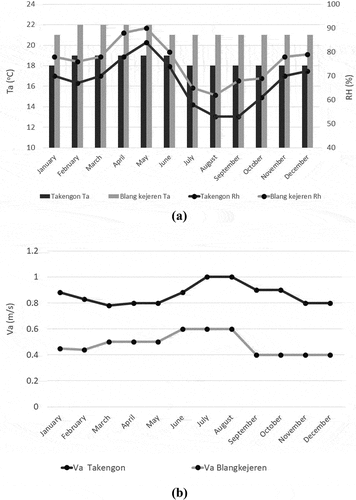
3.2. Mosques descriptions
3.2.1. Asal Penampaan mosque
The Asal Penampaan Mosque () is the oldest mosque in the Aceh province. It was built in 1412 and coincided with the development of Islam in Indonesia. It is located about at 900 m above sea level and 10 m east of the Penampaan riverbank, which has an estuary into the Alas River in the city of Blangkejeren. Gayo Lues as the district area of Blang Kejeren is rich in Suren wood (Toona sureni) which became the most commonly used building material in the earliest time of building construction in Gayo Lues. Suren wood is used for various types of buildings in Blangkejeren.
The mosque is 8.50 m tall from floor to roof. The roof is made of palm fibers, which are also widely available in Gayo Lues, and are called Pango or Aren. The mosque has a wall made from river stone and red soil that measures 140 cm high and 80 cm deep. Red soil is also abundant in Blangkejeren which is also currently used for building construction. The floor is hardened soil which is now plastered with cement and covered with rugs. Over the past 50 years, the roof has only been replaced with new palm fibers, most recently in 2019 due to some leakage. Despite the renovations, generally, this mosque has maintained its original performance. In the late 1990s, a new mosque was built and attached to the original Asal Penampaan Mosque (Khairiah Citation2017). The mosque is modern, employing a dome roof supported by a brickwork wall system.
3.2.2. Tue Kebayakan Mosque
The second oldest mosque which still exists is the Tue Kebayakan Mosque which was the first mosque built in Takengon, Central Aceh, in 1903. It is positioned at 1270 m above sea level and is about 500 m away from Lut Tawar Lake. The mosque was initially built from timber with a serule leaf roof. Traditionally, the roofs of houses in Gayo Highland have been made from serule leaves which are quite abundant in Aceh Tengah. Therefore, it is believed that the roof of the mosque was made from serule leaf when it was initially built. The mosque was relatively the same as the Asal Penampaan mosque which was made from a 140-cm-tall wall made from river stones and soil. It is unclear when the river stone wall was replaced with a brick wall; however, the common use of brick, concrete, and metal is indicative of the era of Dutch colonialism. In 1940, some renovations were carried out (KKN-PPM Citation2015). The building material was changed to have a metal roof made of zinc sheets. The floor was plastered with cement. In 2000, the building was claimed as a cultural heritage site. Due to neglect, the mosque suffers some decay; however, the roof structure is still well preserved ().
3.2.3. Al Jihad Mosque
The third oldest mosque is the Al Jihad Mosque built in 1928, located in Takengon at about 1200 m above sea level (). It was the first largest mosque in Takengon. The mosque is located 8 m away from the banks of the Peusangan river. The wall was initially made fully from timber, sourced from nearby forests (Gunung Kute, Toweren, Mendale, and Blanggele). Local workers and workers from much farther away, like Bener Meriah, came together to complete the original construction of the mosque. The people took turns working together and used canoes or wooden boats to transport materials down the river. In 2009, the mosque was renovated to have a semi-permanent wall by replacing old parts with a 1-m-tall concrete wall for the bottom section of the wall. The renovation also included installing a paving block around the outside of the building, ceramic tile on the indoor floor, and coating the columns with gypsum. The roof was also sealed with gypsum. It was previously open exposing the roof structure to the interior (.c).
3.3. Location of mosque to the nearby river or lake
Water is essential to support mosque activity. Therefore, many old mosques in Indonesia are located near a water source such as a river or lake. The Asal Penampaan Mosque is just 10 m from the Penampaan River; the Tua Kebayakan Mosque is about 500 m from the Lut Tawar Lake, and the Al Jihad Mosque is about 8 m from Peusangan River. This may be due to the reliance on boats and other water transportation in the days before engines. The provision of clean water for the ablution before the prayer was also probably the reason for being close to the river. These old traditional mosques are located near eternal ground wells or constant clean water sources, which some believe to be meaningful or sometimes magical. In Aceh, the eternal ground wells near the old mosques are still actively used, and the water from these wells is believed to have medical efficacy. Near the Asal Penampaan Mosque, a ground well called Telaga Nampak is still used actively for medicine by the local residents. The Al Jihad Mosque also has a consistent water source from the ground well located near the mosque. The local people also believe that the water from this source can cure illness.
3.4. Building floor plan and structure
The floor size of Asal Penampaan () and Tue Kebayakan Mosques () are similar, at about 11.5 by 11.5 m (Sari et al., Citation2018, Citation2020). The size is distinctive because some old mosques in lowland areas such as the Indrapuri Mosque in Aceh Besar have a nearly similar size at 12 by 12 m. One study indicated that the size works perfectly in distributing the sound pressure level within the mosque without an additional mechanical sound system (Sari et al. Citation2020). Meanwhile, the Al Jihad Mosque has a larger floor plan, at about 25 by 24 m (). This is over four times the area of the other mosques (144 m2 compared to 600 m2). There are four main pillars in the center to support the roof load, also present in Asal Penampaan Mosque (.a). The Tue Kebayakan Mosque does not have additional pillars in the middle to support the roof load. Instead, the rooftop structure is supported by two trusses that are directly connected to the pillar at the wall structure (.b). It is indicated that this oldest mosque was originally designed in a simple square form. There were initially no additional rooms, unlike the Tue Kebayakan Mosque which is not square shaped because of the qibla positioned on the outside. The youngest, the Al Jihad Mosque, was designed with three additional rooms in the front, which are normally for the qibla and equipment storage.
The main pillars in the middle of the floor plan are called Saka Guru. The Saka Guru system is the most common characteristic in old mosques in Indonesia (Budi and Wibowo Citation2018). In this system, the four main pillars support load distribution from the roof and distribute it into the foundation. The four main pillars have a symmetrical configuration that helps to carry the vertical and horizontal load including earthquakes. The length of the four columns has been divided into three parts by joint of columns and beams that are connected to the outside columns. The outside columns support the lower part of the roof. The outside columns share the moment distribution from the four main pillars and also add the stiffness of the structure (Koesmartadi and Mohhamad Citation2022). Diminishing the four main pillars might affect larger the moment of beams and outside columns. Tue Kebayakan Mosque did not adopt the Saka Guru structural system, instead to anticipate the larger moment, the rooftop is supported by two trusses (). In this case, the load from the trusses was fully supported by the outside columns.
The roofs of the three mosques are four-sided sloping roofs or pyramid hip roofs in simple style and pyramid-shaped stacked roofs. Across Indonesia, even in other places in Southeast Asia, old mosques are commonly built in this style (Jamaludin and Salura Citation2018). The tops of the roofs have various designs and usually include openings. In Takengon, the Tue Kebayakan Mosque and the Al Jihad Mosque have a roof tilt of around 30°, which is supported by the ring balk at the wall perimeter which transfers the load to the column and the poles. When it was first built, there was no ceiling to hide the roof structure, which created a large and spacious roof loft that accommodated the stairs to reach the top of the roof. It is believed that previously, this roof loft was where someone would sound the Azan or call to prayer. Currently, the modern mosque has a minaret which replaced the roof loft as the location to sound the Azan (). The Al Jihad Mosque also has a spacious roof loft that gives access to parts of the roof.
3.5. Building material
As mentioned above, the Asal Penampaan Mosque is the oldest in Aceh, built before the Dutch colonial period. It was built from a timber structure, palm fiber roof, and a stone and soil wall about 140 cm tall. The building has maintained its original design with materials being replaced over time. The second oldest mosque still standing is the Tue Kebayakan Mosque. It was also initially built in the same style as Asal Penampaan Mosque, with a timber structure, leaf roof, and 1-m-high stone and soil wall. After the renovation, the building was constructed from concrete, and a metal roof was installed. However, the roof structure remained open as the initial old construction. The youngest is Al Jihad Mosque which was built from timber with a wooden structure and metal roof. After the renovation, the mosque wall was converted to brickwork for the bottom section, and the section up to the ceiling is made from wooden planks.
In the oldest mosque, more local materials were used in the structure. Some modern materials such as metal roofs were used in the more recent mosque renovations which came later when these materials became available in the local market. All initial materials applied to the mosque were obtained locally. Using locally sourced construction materials has a significant effect on the sustainability of the building and the environment. The mosques have a low embodied energy consumption. The local material which is obtained a short distance away from the building site minimizes the carbon emissions expended from the transport of the materials (Sari et al. Citation2023). The local material is also adaptive to the environment and, therefore, long-lasting. The Asal Penampaan Mosque proves that the old timber structure, which has lasted for more than 600 years, has been a successful wall-standing material to support the complex roof structure.
3.6. The openings
From the weather data (Weatherspark Citation2022), it was found that Takengon has a lower average air temperature (Ta) and relative humidity (RH), yet higher air velocity (Va) compared with that of Blang Kejeren (). The different climate necessitates different building ventilation and openings. In general, the three mosques have ground wall ventilation and clerestory openings. However, the slightly warmer Ta and lower Va of Blang Kejeren created more ventilations applied to the buildings. The percentage of the window or ventilation area to the floor area in the Asal Penampaan Mosque, i.e. 22.8% which is higher than Tue Kebayakan and Al Jihad mosque in Takengon, respectively. Asal Penampaan mosque has 50-cm-high and 26.4 m2 wide ground wall ventilations which are running along the perimeter of the 140-cm-high wall. The above ventilation which is clerestory has an area of 10.56 m2.The ventilation was designed in carved wood which would let the airflow around 75%.
shows that Tue Kebayakan and Al Jihad mosques have the same style of window, i.e. jalousie type and horizontal awnings carved in wood. Jalousie will also decrease the airflow to 75%. The percentage of window area to the floor area of the two mosques is smaller than that in Asal Penampaan mosque which is 19.73% and 17.35%, respectively. This is due to the few windows built at the mosque. This would provide less airflow to the mosque which is relevant to the local climate, i.e. colder than in Blang Kejeren, therefore, minimizing air flow to reduce the cold thermal sensation. However, due to the relative humidity (RH) in a warm humid climate, the use of jalousie windows allows air to circulate through the openings which can reduce the amount of RH and thus release the warm air generated from patrons’ body heat to the upper ventilation. This creates the thermal comfort sensation in warm humid tropics. The interior warmth is still maintained by this kind of opening. In Takengon, where the air temperature is lower and the air speed is slightly higher, the mosques (Tue Kebayakan and Al Jihad) are surrounded by closed walls with limited windows. The windows are jalousie types and have horizontal awnings.
The old mosques were initially designed with above openings or called clerestory which can flow out too much heat at the top. Clerestory also works well in providing daylight access. The Asal Penampaan and Tue Kebayakan mosques have direct access to the clerestory. However, the Al Jihad mosque has been renovated with significant change, namely the installation of a gypsum ceiling throughout the roof which closes the access to the clerestory (). This allows heat to accumulate in the roof loft. Therefore, air circulation is induced with the additional installation of electrical fans mounted at the columns of the mosque.
4. Discussion
Traditional architecture exhibits sustainable characteristics that consider the climate, topography, and natural environment. In this study, the historical traditional mosques in the Gayo Highland show their abilities in the optimization of the planning, construction, material selection, and energy use decisions. The three mosques evaluated in this study have optimal locations, being close to a river or lake from which patrons are able to source water. The river is an important transportation path in the old time as well as the water source for ablution for the Muslims prior the worship. From interviews with the person taking care of the mosques and some elderly residents who live close to the mosques, we discovered that even though the mosque is very close to the river, it has not been impacted by flooding. The natural environment in previous times really supported this thing where forests were still actively maintained.
The design of the mosque is adaptive to the local climate. The Asal Penampaan Mosque has more openings than the Tue Kebayakan and Al Jihad Mosques. The slightly higher air temperature in Blangkejeren compared with that in Takengon is the reason for more openings that allow for more natural ventilation horizontally and vertically. The closed wall in the two mosques in Takengon is a way to minimize airflow due to lower air temperature and higher air speed compared with that in Blangkejeren. The natural sunlight that comes from the window and the upper ventilation (clerestory) is sufficient to bring light to the indoor area. These characteristics support the sustainability aspect, i.e. minimizing non-renewable energy consumption as well as enhancing indoor environmental quality (IEQ). IEQ is optimally healthy from natural ventilation and sunlight (Sari, Kayan, and Zahriah Citation2022).
The simple and square layout as well as single module supported with saka guru structure perform to withstand the earthquake (Prihatmaji Citation2007) (). Asal Penampaan mosque and Al Jihad mosque are the oldest mosques with the saka guru system. As mentioned before, this system could withstand an earthquake due to the load distribution between the four main pillars to the outside pillars. The four main pillars also receive load distribution from the sloping roof through the beams that connect the main columns or pillars with the outer columns around the building. The configuration of the four main pillars and also the outside pillars is usually symmetrical that can add the stiffness of each column. The four main pillars reduced the moment that occurs in the beam that support the load from the rooftop. This benefits the resistance to the earthquake load.
Figure 12. (A) Saka Guru system, (b) mortise and tenon joint system (Prihatmaji Citation2007), applied in Asal Penampaan mosque.
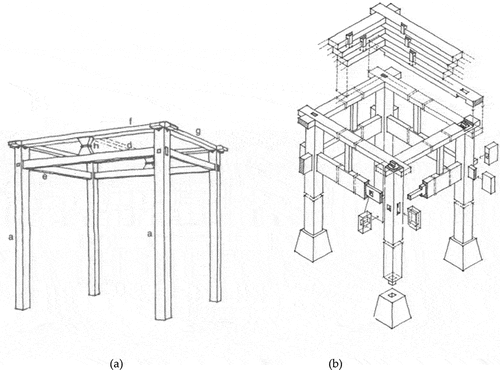
The joint system of the structure is a mortise and tenon joint system which is a traditional structure that can endure earthquakes for centuries (Nursaniah et al. Citation2022). In this system, the mortise part is on the beam and the tenon on the column which is connected to form a tongue connection. Meanwhile, at the third point, there is a connection between the beams that distribute the load of the building in the form of the lower roof from the four sides of the building.
In the days when the mosques were built, the materials used in mosque construction, such as timber and sago leaf, were local. The Asal Penampaan Mosque in Blangkejeren has been maintained to perform traditionally. This supports the sustainability characteristics of using environmentally preferable products and materials. The use of timber in building construction has a low CO2 emission which reduces 10% of carbon released, compared with the current buildings constructed from concrete and metal (Neslen Citation2022). Using timber in construction would prevent up to 106 bn tons of carbon emissions by 2100 (Communications Citation2022; Neslen Citation2022). The use of sago leaf for roofs is also beneficial to the users of the building as it prevents overheating.
The preservation of the Asal Penampaan Mosque has been maintained by the local people and supported by the government. Therefore, there have been no significant renovations. The historical preservation was done mostly through maintenance by using the same building materials. The timber structures are nicely preserved (.a). Meanwhile, the Al Jihad Mosque, especially the interior, has been renovated extensively. The ceiling, pillars, and wall surfaces are coated with gypsum. The local residents prioritized a modern look during the renovation. From a structural observation, this might decrease the quality of the roof structure due to an increased load (the gypsum ceiling) carried by the wooden structure of the roof. The roof loft which is separated by gypsum sheets causes higher humidity due to less air being circulated. The timber planks look humid and black because of the fungus. This makes the roof structure vulnerable. The use of gypsum ceiling closing the top ventilation also creates an overly warm sensation for patrons who use the mosque during the day (). Especially on Friday, when Muslims perform the jum’ah prayer which is compulsory for men, the mosque is fully occupied which creates a warmer condition due to the body heat of the worshippers. Because of this, the Al Jihad Mosque has wall-mounted fans installed in the interior of the mosque.
The Tue Kebayakan Mosque still has an exposed roof structure. The current metal roofs and plastered brickwork replaced the old material. Zinc sheet roofs mean overheating during the day and coldness during the night. When the mosque had a leaf roof before the current metal roof, it did not face these temperature issues. Optimizing the operational and maintenance practice in the traditional mosques was simple due to the availability of the local material and the cooperation carried out by the community. Currently, the scarcity of local materials is a major issue. Local forests have been decimated, and no effort has been made to replant the tree population. As previously discussed, the new material installed in the traditional mosque will probably harm the mosque structure. There will be negative impacts on the environment due to the increased carbon emissions released by new unsustainable materials and structures. This is a big challenge to maintain sustainability. Once the sustainable tree replantation is carried out, then there is an opportunity to preserve the timber mosque through the consideration of the friendly-environmental design. However, despite some renovations applied to the mosque, the three mosques have the structure, material, and design that are adaptive to the environment; characteristics of low embodied energy from the local sourcing of construction materials; and can endure earthquakes.
5. Conclusion
Old traditional mosque is one of the best designs in architecture in representing sustainability by being adaptive to the environment and the local climate. In this study, three old traditional mosques in the Gayo Highland region in Indonesia were evaluated regarding their sustainability characteristics, which are concluded as follows:
Takengon is the highest elevation in Gayo which has cold air temperatures due to the influence of the mountainous topography. The condition is balanced by the solid wall with limited openings that keeps in the warmth of the room of the mosques. In Blangkejeren, also located in the highlands but with slightly cooler temperatures, the wall of the mosque provides more openings running along the wall perimeter. This induces natural ventilation allowing daylight and air into the interior.
In both Takengon and Blangkejeren, the mosque roof also provides attic ventilation. The roof ventilation (clerestory) works as a stack effect that flows the too-warm temperature and excessive relative humidity performed by the worshippers’ metabolic rate out of the buildings.
The building materials are locally sourced, except for the use of zinc sheets for the roofs of Tue Kebayakan and Al Jihad, which were imported. The use of local timber promotes low carbon emissions due to the low embodied energy of wood. The lightweight structure, i.e. wood, also allows for comfortable temperatures in the warm humid region due to its low thermal mass characteristic
The two old mosques, i.e. Asal Penampaan and Al Jihad mosque, use Saka Guru technique located in the middle of the structure which allows for the mosque to withstand earthquakes. The mosques are also supported by the mortise and tenon joint system. These traditional designs work well to support the mosque to survive for over a hundred years
The location where the mosque was erected is also well regarded by the local elderly residents. The close proximity to the river or lake provides a source of reliable, clean freshwater for the worshippers to perform the prayer.
This study is a preliminary work which frames the sustainability only from the mosque design performance. The absence of field measurement data on thermal comfort and indoor daylight quantity in this current study proposes future research that should carry out a more adequate investigation through field measurement and energy-building simulations.
Acknowledgements
The authors would like to thank DRTPM of Indonesia for funding this research through PDKN research grant (Research contract: 42/UN11.2.1/PT.01.03/DPRM/2022). Our gratitude also goes to the students of the Architecture Department of Universitas Syiah Kuala for helping to conduct the data collection.
Disclosure statement
No potential conflict of interest was reported by the authors.
Additional information
Funding
Notes on contributors
Laina H Sari
Dr. Laina Hilmasari, S.T., M.Sc., is a researcher and lecturer at the Department of Architecture, Faculty of Engineering, Syiah Kuala University (USK). Her educational background is ”sustainable architecture”. Laina completed her Masters's and Doctoral programs at Heriot-Watt University in Edinburgh, Scotland, United Kingdom. She has extensive research experience in vernacular housing and historical buildings such as old mosques. Several of Laina's works have been published in the form of scientific articles published in Sinta-Indonesian national indexed journals and Scopus-indexed international journals. She also wrote several books. Some of her books are entitled 'Aceh Historic Mosques in the Perspective of Architectural Spatial Comfort; and Sun Path Diagram in Architecture published by Syiah Kuala University Press, 2018 and 2021; and ‘Environmental Architecture’ published by Bandar Publishing in 2021.
Elysa Wulandari
Dr. Ir. Elysa Wulandari, M.T was born on April 19, 1964, in Yogyakarta and is a lecturer in the Urban and Regional Planning Study Program, Department of Architecture, Faculty of Engineering, USK since 1990 until now. She completed her Bachelor of Architectural Engineering, Department of Architecture, Faculty of Engineering, Gadjah Mada University in 1989, and continued her Masters in Architectural Engineering at the Bandung Institute of Technology Postgraduate Program in 1998. Later, she completed her Doctoral Degree in Architecture and Urban Engineering at Diponegoro University in 2017. Her research interests are Architecture Urban History; and the Development of Coastal Areas and Settlements.
Yunita Idris
Dr. Yunita Idris, S.T., M.Eng.Structure or usually called Yunita is a researcher at the Tsunami and Disaster Mitigation Research Center (TDMRC) at Syiah Kuala University (USK) as well as a Lecturer at the Civil Engineering Study Program, Faculty of Engineering Unsyiah, Darussalam, Banda Aceh. Her scientific discipline is civil engineering, specifically regarding building construction. Yunita completed her doctoral degree at the University of Adelaide, Australia, in the field of research on seismic behaviour in building construction made of composite materials of concrete, steel and fibre. Her research has been published in internationally accredited journals, one of which is in the journal Earthquake Engineering in 2019 with the title ”Post-Earthquake Damage Assessment after the 6.5 Mw Earthquake on December, 7th 2016 in Pidie Jaya, Indonesia” . He also has some experience in assessing building damage due to earthquakes such as joining the Unsyiah TDMRC team for rapid damage assessment due to the 2016 Pidie Jaya earthquake, then being sent by the Government of Aceh as a team for rapid assessment of earthquake damage to Lombok, West Nusa Tenggara, in 2018. In the same year Yunita joined the EEFIT –TDMRC team (a joint British and Unsyiah researchers) for a field assessment to Palu, Central Sulawesi, after the Palu earthquake.
References
- Akyıldız, N. A., and T. Olğun. 2020. “Investigation for Energy Use and Conservation of Sustainable Traditional Architecture: Case of Malatya/Turkey Bahri Mosque.” Architecture Research 10 (2): 60–67.
- Arfiansyah. 2020. “Islam dan Budaya Masyarakat Gayo, Provinsi Aceh:.” Jurnal Sosiologi Agama Indonesia 1 (1): 1–31. https://doi.org/10.22373/jsai.v1i1.482.
- Aslani, A., A. Bakhtiar, and M. Akbarzadeh. 2019. “Energy-Efficiency Technologies in the Building Envelope: Life Cycle and Adaptation Assessment.” Journal of Building Engineering 21:55–63. https://doi.org/10.1016/j.jobe.2018.09.014.
- Bloszies, C. 2012. Old Buildings New Designs. New York: Princeton Architectural Press.
- Budi, B. S. 2004. “A Study on the History and Development of the Javanese Mosque. Part 1: A Review of Theories on the Origin of the Javanese Mosque.” Journal of Asian Architecture and Building Engineering 3 (1): 189–195. https://doi.org/10.3130/jaabe.3.189.
- Budi, B. S., and A. S. Wibowo. 2018. “A Typological Study of Historical Mosques in West Sumatra, Indonesia.” Journal of Asian Architecture and Building Engineering 17 (1): 1–8. https://doi.org/10.3130/jaabe.17.1.
- Communications, N., 2022. Environment: Timber Housing Could Reduce CO2 Emissions. Accessed November 1, 2022. https://www.natureasia.com/en/research/highlight/14197/.
- Firląg, S., and M. Piasecki. 2018. “NZEB Renovation Definition in a Heating Dominated Climate: Case Study of Poland.” Applied Science 8 (9): 1605. https://doi.org/10.3390/app8091605.
- Fouseki, K., K. S. M. C. David Newton, N. Sohini, and K. Theodora. 2020. “Energy Efficiency, Thermal Comfort, and Heritage Conservation in Residential Historic Buildings as Dynamic and Systemic Socio-Cultural Practices.” Atmosphere 11 (6): 604. https://doi.org/10.3390/atmos11060604.
- Gayo, H. 2022. Gayo Highlands Travel Guide. [ Online]. https://www.traveldojo.com/gayo-highlands/.
- Ghassan, M. L., L. H. Sari, and A. A. Munir 2021. “An Evaluation of the Tropical Architectural Concept on the Building Design for Achieving Thermal Comfort (Case Study: Engineering Faculty of Syiah Kuala University).” IOP Conference Series: Materials 15-16 Otober 2020 Banda Aceh. 1087: 012013. https://doi.org/10.1088/1757-899X/1087/1/012013.
- Idham, N. 2019. “Indonesian Architecture and Earthquake Vulnerability: The Development of Building Safety Through the Civilization.” In MATEC Web of Conferences, EDP Sciences 11-12 October 2019 Banjarmasin. 280: 01004. https://doi.org/10.1051/matecconf/201928001004.
- Jamaludin, J., and P. Salura. 2018. “Understanding the Meaning of Triangular Shape in Mosque Architecture in Indonesia.” International Journal of Engineering & Technology 7 (4.7): 458–462. https://doi.org/10.14419/ijet.v7i4.7.27359.
- Kariuki, D. W. 2021. External Shading for Passive Thermal and Daylighting Design a Case of Small Learning Spaces in Tropic Upland Climate of Nairobi. Nairobi: Doctoral dissertation, University of Nairobi.
- Khairiah. 2017. Masjid Asal Penampaan Di Kabupaten Gayo Lues. Banda Aceh, Indonesia: Balai Pelestarian Cagar Budaya Aceh.
- KKN-PPM. 2015. Mesjid Tua Kebayakan. [ Online]. Accessed November 3, 2022. https://kampung-bukit.blogspot.com/2015/04/mesjid-tua-kebayakan.html.
- Koesmartadi, C., and K. Mohhamad. 2022. “Pengkinian Konstruksi Joglo Tanpa Empat Saka Guru: Studi Kasus: Pendopo Pura Agung Blambangan Banyuwangi.” ATRIUM: Jurnal Arsitektur 3 (8): 199–210. https://doi.org/10.21460/atrium.v8i3.195.
- Lami, I., and B. Mecca. 2021. “Assessing Social Sustainability for Achieving Sustainable Architecture.” Sustainability 13 (1): 142. https://doi.org/10.3390/su13010142.
- Liu, S., Y. T. Kwok, K. K.-L. Lau, H. W. Tong, P. W. Chan, and E. NG. 2020. “Development and Application of Future Design Weather Data for Evaluating the Building Thermal-Energy Performance in Subtropical Hong Kong.” Energy & Buildings 209:209. https://doi.org/10.1016/j.enbuild.2019.109696.
- Looman, R. 2017. “Climate-Responsive Design: A Framework for an Energy Concept Design-Decision Support Tool for Architects Using Principles of Climate-Responsive Design.” Architecture and the Built Environment 19 (1): 1–282.
- Lu, Y., and J. Qian. 2020. “Towards a Material Approach in Rural Geography: Architectural Experiments in China’s Rural Renaissance and Reconstruction Movements.” Geoforum 116:119–129. https://doi.org/10.1016/j.geoforum.2020.08.006.
- Najjar, M., K. Figueiredo, A. Hammad, and A. Haddad. 2019. “Integrated Optimization with Building Information Modeling and Life Cycle Assessment for Generating Energy Efficient Buildings.” Applied Energy 250:1366–1382. https://doi.org/10.1016/j.apenergy.2019.05.101.
- Neslen, A., 2022. Timber Cities ‘Could Cut 100bn Tons of CO2 Emissions by 2100. [ Online]. Accessed November 1, 2022. https://www.theguardian.com/environment/2022/aug/30/timber-cities-could-cut-100bn-tons-of-co2-emissions-by-2100.
- Nguyen, A. T., N. S. H. Truong, D. Rockwood, and A. D. Tran Le. 2019. “Studies on Sustainable Features of Vernacular Architecture in Different Regions Across the World: A Comprehensive Synthesis and Evaluation.” Frontiers of Architectural Research 8 (4): 535–548. https://doi.org/10.1016/j.foar.2019.07.006.
- Nihan, K., N. Shah, W. Y. Park, N. Khanna, C. Ding, J. Lin, N. Zhou, et al. 2020. “Improving the Energy Efficiency of Room Air Conditioners in China: Costs and Benefits.” Costs and Benefits Applied Energy 258:114023. https://doi.org/10.1016/j.apenergy.2019.114023.
- Nursaniah, C., I. Machdar, A. Azmeri, and A. Munir. 2022. “Essential Transformation of Mortise-And-Tenon Joints for Earthquake-Resistant Contemporary Housing (A Case Study in the Aceh Province, Indonesia).” International Journal on Advanced Science, Engineering and Information Technology 12 (1): 320. https://doi.org/10.18517/ijaseit.12.1.14444.
- Nursaniah, C., I. Machdar, and A. Munir. 2021. “Understanding Aceh’s Contemporary Architecture: Neuheun Mandiri Housing, in the Hills of Aceh Besar Coastal Village.” IOP Conference Series: Earth and Environmental Science 881 (1): 012041. https://doi.org/10.1088/1755-1315/881/1/012041.
- Nwalusi, D., N. Obi, I. Chendo, and F. Okeke. 2022. “Climate Responsive Design Strategies for Contemporary Low-Rise Residential Buildings in Tropical Environment of Enugu, Nigeria.” IOP Conference Series: Earth and Environmental Science 1054 (1): 012052. https://doi.org/10.1088/1755-1315/1054/1/012052.
- Prihatmaji, Y. P. 2007. “Perilaku Rumah Tradisional Jawa “Joglo” Terhadap Gempa.” Dimensi Teknik Arsitektur 35 (1): 1–12. https://doi.org/10.9744/dimensi.35.1.1-12.
- Rinaldi, M., and P. Multahadi Bintang. 2021. “Kajian Elemen Pembentuk Citra Kota Takengon.” Senthong 4 (1): 296–305.
- Rosana, C., and J. S. Juan. 2020. “Evaluation of Indoor Environment and Energy Performance of Dwellings in Heritage Buildings. The Case of Hot Summers in Historic Cities in Mediterranean Europe.” Sustainable Cities and Society 52:101798. https://doi.org/10.1016/j.scs.2019.101798.
- Ruggerio, C. 2021. “Sustainability and Sustainable Development: A Review of Principles and Definitions.” Science of the Total Environment 786:14781. https://doi.org/10.1016/j.scitotenv.2021.147481.
- Sari, L., I. Izziah, and E. Meutia. 2018. Mesjid bersejarah Aceh dalam perspektif kenyamanan spasial arsitektur. Banda Aceh, Indonesia: Syiah Kuala University Press. https://doi.org/10.52574/syiahkualauniversitypress.338.
- Sari, L., I. Izziah, E. Meutia, and Z. Zulfian. 2020. “The Evaluation of Thermal, Room Acoustics and Daylight Performance of Old Indrapuri Mosque in Aceh Besar, Indonesia.” Malaysian Journal of Sustainable Environment 6 (1): 57–72. https://doi.org/10.24191/myse.v6i1.8679.
- Sari, L. H., B. Kayan, and Z. Zahriah. 2022. “An Assessment of Indoor Environmental Quality in COVID-19 Affected Houses: A Case Study in Banda Aceh, Indonesia.” International Journal of Building Pathology and Adaptation Issue ahead-of-print. https://doi.org/10.1108/IJBPA-02-2022-0033.
- Sari, L. H., Kayan BA, Zahriah Z, Taqiuddin Z, Nursaniah C, Mohd Konar SN. 2023. “Paint Repair Appraisal for Heritage Buildings: The Adoption of Green Maintenance Model in Banda Aceh and Melaka.“ Journal of Cultural Heritage Management and Sustainable Development 1. https://doi.org/10.1108/JCHMSD-11-2022-0192.
- Sari, L. H., and E. N. Rauzi. 2021. “An Evaluation of Shading Device in Tropics Utilising the Sun-Path Diagram.” ARTEKS : Jurnal Teknik Arsitektur 6 (3): 373–382. https://doi.org/10.30822/arteks.v6i3.877.
- Sharif, Z. M., N. J. Jalil, and B. H. A. Bekhet. 2018. “Green Building, Sustainability and Mosques Design in Kuala Terengganu.” International Journal of Engineering & Technology 1 (1): 8.
- Sharif, Z. M., N. J. Jalil, and H. A. Bekhet. 2019. “Green Building, Sustainability and Mosques Design in Kuala Terengganu.” International Journal of Engineering & Technology 8 (1): 228–234.
- Sobri MI, Ismail S, Sabil A, Yusof H, Asif N, Setiyowati E. 2021. “Systematic Review of Sustainable Design Approach for Mosque.” Journal of Islamic Architecture 6 (4): 369–375. https://doi.org/10.18860/jia.v6i4.14016.
- Sufi, R. 2013. Gayo: Sejarah dan Legenda. Banda Aceh, Indonesia: Badan Arsip dan Perpustakaan Aceh.
- Šujanová, P., M. Rychtáriková, T. Sotto Mayor, and A. Hyder. 2019. “A Healthy, Energy-Efficient and Comfortable Indoor Environment, a Review.” Energies 12 (8): 1414. https://doi.org/10.3390/en12081414.
- Tolibjonovich, M. T., and G. O. R. Ugli. 2021. “Eastern Renaissance and Its Cultural Heritage: The View of Foreign Researchers.” ResearchJet Journal of Analysis and Inventions 2 (5): 211–215.
- Weatherspark. 2022. Weather Spark. [ Online]. https://weatherspark.com/compare/y/112458~112592/Comparison-of-the-Average-Weather-in-Takengon-and-Blangkejeren.
- Wulandari, R. 2021. “Budaya Ketahanan Gempa pada Arsitektur Masjid Tradisional Indonesia.” PURBAWIDYA: Jurnal Penelitian Dan Pengembangan Arkeologi 10 (1): 87–102. https://doi.org/10.24164/pw.v10i1.393.

